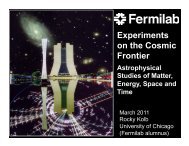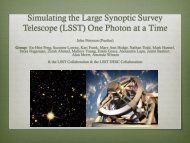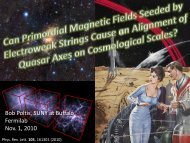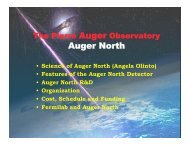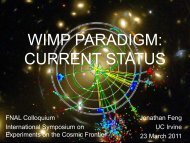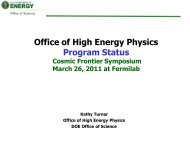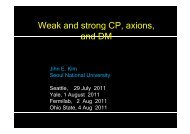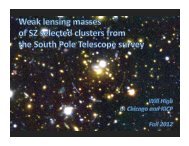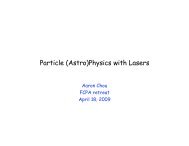Cosmic Surveys – Rich Kron - Fermilab Center for Particle ...
Cosmic Surveys – Rich Kron - Fermilab Center for Particle ...
Cosmic Surveys – Rich Kron - Fermilab Center for Particle ...
Create successful ePaper yourself
Turn your PDF publications into a flip-book with our unique Google optimized e-Paper software.
<strong>Cosmic</strong> <strong>Surveys</strong><br />
<strong>Rich</strong> <strong>Kron</strong><br />
17 April 2009<br />
<strong>Fermilab</strong> <strong>Center</strong> <strong>for</strong> <strong>Particle</strong> Astrophysics retreat<br />
outline:<br />
SDSS (I, II, & III)<br />
DES
Madrid & Macchetto arXiv:0901.4552v1 analyzed<br />
the 200 most-cited papers published in 2006 and<br />
found that SDSS was “once again the telescope<br />
with the highest impact in astronomy.”
This high impact is due to several factors:<br />
freely accessible database (dr7: arXiv 0812.0649)<br />
processing and calibrations: science-ready data<br />
uni<strong>for</strong>m and high-quality data<br />
large footprint on the sky<br />
overlap with other major surveys (2MASS, GALEX)<br />
data useful across many fields of astronomy<br />
----------way<br />
the telescope is used<br />
SDSS Collaboration as a scientific team
SDSS-II (2005 - 2008) extension survey: same<br />
instrumentation, same target-selection <strong>for</strong> Legacy,<br />
improvements to processing software <strong>for</strong> Legacy.<br />
Legacy required 1/3 of the total time to “fill the<br />
gap.” The other 1/3 and 1/3 were <strong>for</strong>:
SEGUE (Sloan Extension <strong>for</strong> Galactic<br />
Understanding and Exploration):<br />
Deliberate spectroscopic targeting of stars.<br />
Development of new code <strong>for</strong> extraction of Teff,<br />
log g, [Fe/H], and higher-precision radial<br />
velocities (5 km sec -1 <strong>for</strong> brighter stars).<br />
New code <strong>for</strong> stellar photometry in crowded<br />
fields.<br />
237,000 stellar spectra, 3500 deg 2 new imaging
Bullock, J. & Johnston, K. 2005 ApJ 635, 931
“hyper-velocity star”<br />
Brown, W.R. et al. 2007 ApJ 671, 1708<br />
v = 600 km sec -1<br />
RGC = 82 kpc<br />
tGC = 124 Myr
Supernova: light curves <strong>for</strong> Type Ia supernovae<br />
with 0.05 < z < 0.35. This redshift range is natural<br />
<strong>for</strong> SDSS capabilities and complements other<br />
surveys.<br />
Spectroscopic follow-up (to confirm type and to<br />
obtain redshifts) requires other telescopes.<br />
Development of on-the-mountain processing <strong>for</strong><br />
rapid identification of candidates; code<br />
development <strong>for</strong> precision photometry.
SNe Survey<br />
N S<br />
Use the SDSS 2.5m telescope<br />
• September 1 - November 30 of 2005-2007<br />
• Scan 300 square degrees every 2 days<br />
• Obtain multi-color light curves<br />
• >90% efficiency after ~2 - 4 epochs
SDSS SN Photometry<br />
Holtzman etal<br />
(2008)
Hubble Diagram<br />
with SDSS SNe<br />
103 SNe Ia from first<br />
season<br />
Kessler etal (2009)<br />
Lampeitl etal (2009)<br />
Sollerman etal (2009)<br />
~45 SNe Ia<br />
~120 SNe
SDSS-II had 25 institutional partners, including:<br />
Fermi National Accelerator Laboratory<br />
Los Alamos National Laboratory<br />
Joint Institute <strong>for</strong> Nuclear Astrophysics<br />
Kavli Institute <strong>for</strong> <strong>Particle</strong> Astrophys & Cosmology
S. Allam HST Cy16Sup GO-11974<br />
<strong>Fermilab</strong> science:<br />
Luminous Red Galaxies<br />
clusters<br />
supernovae<br />
lensing<br />
photometric redshifts<br />
structure of the Milky Way<br />
<strong>Fermilab</strong> technical:<br />
calibration<br />
simulations<br />
pipelined data processing<br />
data quality assurance<br />
accessible databases<br />
project management
SDSS-III: baryon acoustic oscillations discovered<br />
in SDSS spectroscopic data: error in length scale<br />
from 2005 data ~ 4% at z = 0.35.<br />
Can get 7x SDSS volume with a new survey with<br />
upgraded hardware (smaller fibers, more fibers,<br />
and extended red sensitivity). 1.5 x 10 6 galaxies,<br />
1% error on length scale at z = 0.6.<br />
Also look <strong>for</strong> BAO in Lyman α <strong>for</strong>est using a<br />
denser network of quasars enabled by better blue<br />
CCD’s. 160,000 quasars, 1.5% error on length<br />
scale at z = 2.2.
Bright time can be well used with a new benchmounted<br />
spectrograph (APOGEE).<br />
300 fibers<br />
H band<br />
R = 22,000<br />
100,000 stars (e.g. K<br />
giants selected via<br />
2MASS photometry)<br />
science is to establish abundance patterns &<br />
kinematics across the disk of the Milky Way
6-year survey, observations starting September<br />
2008. Operations proposal to DoE positively<br />
reviewed but allocation still not known; partner<br />
contributions (29+) higher than projected.<br />
While instrument upgrades are in process,<br />
continue with more imaging of the Southern<br />
Galactic Cap, plus SEGUE-2.<br />
MOU with <strong>Fermilab</strong> enables four scientists to<br />
participate (in addition to JP and RK) in science<br />
analysis. This gives <strong>Fermilab</strong> some access to<br />
spectroscopy of LRG’s and quasars.
• Study Dark Energy using<br />
The Dark Energy Survey<br />
4 complementary* techniques:<br />
I. Cluster Counts<br />
II. Weak Lensing<br />
III. Baryon Acoustic Oscillations<br />
IV. Supernovae<br />
• Two multiband surveys:<br />
5000 deg 2 g, r, i, z,Y<br />
smaller area repeat (SNe)<br />
• Build new 3 deg 2 camera<br />
and Data management sytem<br />
Survey 2011-2016 (525 nights)<br />
Blanco 4-meter at CTIO<br />
*in systematics & in cosmological parameter degeneracies<br />
*geometric+structure growth: test Dark Energy vs. Gravity
F8 Mirror<br />
CCD<br />
Read out<br />
Hexapod<br />
Optical<br />
Lenses<br />
DECam<br />
Filters<br />
Shutter<br />
3556 mm<br />
1575 mm
Zekser, K. et al.<br />
2006 ApJ 640, 639.<br />
Abell 1689
Staniszewski, Z. et al. arXiv 0810.1578v1
<strong>Fermilab</strong> is the host institution <strong>for</strong> the project.<br />
DECam: CD3a/b approval October 2008<br />
outcomes are:<br />
1) the science from the data<br />
2) a facility instrument, with data processing<br />
pipeline, available <strong>for</strong> public use
A collaboration perspective of<br />
The DES Organization<br />
John Peoples: DOE-NSF Review 9 September, 2008<br />
27
<strong>Fermilab</strong><br />
UIUC/NCSA<br />
The University of Chicago<br />
Lawrence Berkeley National Laboratory<br />
The National Optical Astronomy Observatory<br />
Spain DES Collaboration<br />
United Kingdom DES Collaboration<br />
The University of Michigan<br />
DES-Brazil Consortium<br />
The University of Pennsylvania<br />
Argonne National Laboratory<br />
Ohio State University<br />
Santa Cruz-SLAC-Stan<strong>for</strong>d DES Consortium
<strong>Fermilab</strong> also has significant involvement on the<br />
science side. Science Committee chaired by J.<br />
Frieman and O. Lahav.<br />
Working Groups:<br />
Large-Scale Structure (E. Gaztanaga, W. Percival)<br />
Clusters (T. McKay, J. Mohr)<br />
Supernovae (J. Marriner, R. Nichol)<br />
Weak Lensing (B. Jain, S. Bridle)<br />
Simulations (A. Evrard, A. Kravtsov)<br />
Photo-z’s (H. Lin, F. Castander)
Study Groups:<br />
Theory/Combined Methods (W. Hu, J. Weller)<br />
Strong Lensing (L. Buckley, M. Makler)<br />
Quasars (R. McMahon, P. Martini)<br />
Galaxy Evolution (R. Wechsler, D. Thomas)<br />
Milky Way Structure (B. Yanny, B. Santiago)
Level 2 Managers:<br />
• bring L2 subsystem into<br />
operation on budget and sched.<br />
• prepare monthly reports and schedule<br />
updates<br />
• coordinate with other L2 Managers<br />
DECam Work Breakdown Structure<br />
Brenna Flaugher Sept. 26,2006<br />
31
SDSS and DES imaging comparison<br />
pixel size 0.40 arcsec 0.27 arcsec<br />
solid angle 1.55 deg 2 3.0 deg 2<br />
aperture 2.5 meters 4.0 meters<br />
PSF 1.4 arcsec 0.8 arcsec<br />
exposure 54 seconds 320 seconds<br />
point-source flim = 1 flim ~ 1/7, or 2 mag<br />
detection<br />
in addition, DES has much more sensitive z band,<br />
plus the Y band (but no u band)
conclusions:<br />
SDSS and DES have established a track record <strong>for</strong> FNAL leadership<br />
in building and conducting cosmic surveys (science and technical).<br />
We have experience in building data processing, database, and<br />
archive systems; building a working multi-institutional scientific<br />
collaboration; and building a focal plane.<br />
We have developed internal scientific expertise in key areas related to<br />
cosmology, and can help catalyze broader participation to advance<br />
the field.<br />
Connecting surveys is natural, e.g. DES + VISTA + SPT + SkyMapper.<br />
All of this means we are well placed <strong>for</strong> the next survey!



